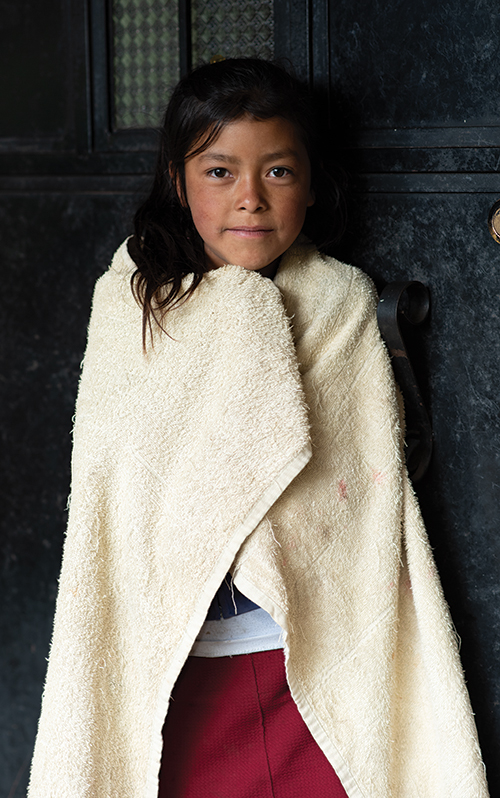
Sometimes the greatest superpower is hope. Clad in a Superman-logoed sweatshirt, this youngster from the impoverished Guatemalan village of El Zapotillo faces his future with strength and hope. This haunting portrait is one of hundreds taken by Tipmont REMC CEO and Project Indiana Board President Ron Holcomb.
 The statistics are compelling. But numbers never tell the whole story.
The statistics are compelling. But numbers never tell the whole story.
The bigger story is the lives Project Indiana changes — men, women and especially children — here in Indiana and there in Guatemala.
A labor of love
The electric cooperative linemen from throughout the state who volunteered on any of the three Project Indiana mission trips over the past six years would agree: helping to change others’ lives changed their lives as well. Take Decatur County REMC lineman Brian AmRhein who helped electrify the remote northeastern village of Sepamac in 2015 for instance. “I was an Army veteran, deployed twice to Iraq,” he said. “All I’ve seen there is war. But going to Guatemala, I’ve seen a different part of life. I’ve seen love … and it changed my life.”
Love is something the Guatemalan villagers have in abundance, even though their possessions are few and far between. Despite language barriers and cultural differences, enduring relationships are formed every time the villagers interact with members of the Project Indiana team. Those relationships make Project Indiana, a 501(c)(3) organization founded by Indiana Electric Cooperatives, special for all involved. ”I think we did something really neat that was life-changing for the families of Sepamac,” said Keith Combs, a lineman at RushShelby Energy who helped string 11 miles of line and connect 76 primary and secondary poles, all by hand, when he was in Guatemala. “The friendships built amongst the linemen and people in the village … I’ll end up taking that to the grave with me.”
Project Indiana Board President Ron Holcomb, who’s made several trips to Guatemala over the past couple of years, focuses on friendships made when talking about the Central American people. “They’re just like you,” he said. “They have the same hopes, the same dreams. They want the same things for their children. They want the same things for their families that we do.
“We tend to think of people from other countries as different from us in some way. They’re not.”
Just like here, the Guatemalans’ primary focus is on families and children. But, unlike most families in our country, those in Guatemala face tremendous difficulties. Dubois REC lineman Tyler Asbell, a 2017 Project Indiana volunteer, recalls those difficulties from his time in El Zapotillo, the village he helped electrify. “It’s a hard life,” he said, describing the back-breaking work that villagers face every day with no modern conveniences to lighten the load. “I don’t think very many Americans would survive there.”

When morning temperatures dip below freezing, young El Zapotillo villager Maralinda tries to keep warm with a towel since she has no coat.
But survive they do. That survival instinct is ingrained in the villagers early on. Many of the kids never have childhoods, because if you don’t learn to take care of yourself early on you probably won’t make it.
It was impossible for men like NineStar Connect’s Jeff Conley, a volunteer in 2015, not to empathize with those hardworking children, and commit himself to doing what he could to make sure they could look forward to a brighter future. “Their parents and grandparents are not going to be there forever. But those kids are going to grow up with that little bit of culture that we bring and instill in them. It was just an amazing feeling.”
Faces of the children
During his trips to Guatemala, Holcomb takes photos of the villagers. On return trips, he shares these portraits with them and they hang those images on their walls.
There’s a million words in each of his photographs, especially of children — a million piercing ways they stick with you. Like the photo of 6-year-old Jennifer, serious beyond her years.
And 9-year old Maralinda, with no coat, only a towel to warm her in 30-degree morning temperatures.
The children’s eyes are often bloodshot since they live inside homes with inadequate ventilation and their food is prepared over fire. Their water is often contaminated. They have significant dental problems in their early teens because of malnutrition. In fact, half of Guatemala’s children under five suffer from chronic malnutrition. It’s highest in the rural areas that Project Indiana serves.
“That bothers me the most, knowing how hungry those kids are and how chronic malnutrition will affect them the rest of their lives,” said Scott Sikora, Kankakee Valley REMC lineman and 2015 Project Indiana volunteer.
Lineman Bob Palmer of Tipmont REMC was shocked by the hardships endured by the villagers when he volunteered in 2012. “I had no idea people actually, truly lived that way,” he said.
“That country doesn’t suffer fools. If you’re not tough and capable, it will eat you up,” Project Indiana Board Member Randy Price said, comparing the Guatemalan lifestyle to that in our country. “As we work with our own children here at home and they get second, third and fourth chances, in Guatemala, I’m not sure they get the first chance. It’s tough.”
Children as young as two years old herd sheep. Everyone in the family is expected to work and contribute to the family’s meager success. Even when education might be a choice for some of them, their labor is more valued. So, they go to work.
Jackson County REMC lineman David Guthrie has memories from El Zapotillo “of these little tykes running around, holding on to the horse ropes when they’re three feet tall and they’re out there handling 700 to 800-pound animals. That’s just life for them.”
And girls like Guadalupe spend four to five hours a day hand-grinding corn into meal and fetching water from a well. A bright and eager 13-year-old, she proudly graduated from sixth grade in El Zapotillo, but can go no further.
Children like these spur Project Indiana volunteers to go beyond stringing wires to helping build schools and even digging into their own pockets to purchase school supplies. Project Indiana is also trying to get a junior high school started in the remote village of Agua Dulce so children can go to school to at least the eighth grade.
Supporting the growth of the cooperative business model in Guatemala will also make a difference. Because Guatemala is heavily rural, co-ops in Guatemala actually educate more children than the government does.
It’s no coincidence Project Indiana started here. “We’re kind of trailblazers,” Jennifer Rufatto, Project Indiana’s executive director and vice president of communication and human resources at Indiana Electric Cooperatives, noted. “The electric co-ops in Indiana led the nation on many fronts. It’s just in our DNA. I’m very grateful to Indiana and all the electric co-ops for having the vision to do this.”
Not only do Indiana’s electric cooperatives have the vision; they want to be there years into the future. “I just want to go back in 10 years and see where they’re at now, and how it’s helped,” said Eric Schlarf, Fulton County REMC lineman and 2015 Project Indiana volunteer.
“We needed to make a difference.”
Rufatto said she feels called to do this work. “When God calls, He will keep hunting you down.” She laughs quickly, then turns serious. “And so you answer. The villagers will do whatever it takes to make their lives better. They work just as hard as we do, if not harder, and they are trusting strangers from another country to follow up on their word, so I don’t want to be that American that made promises and walked away and left broken hopes. I think that’s what makes Indiana different.”
Rufatto’s work for Project Indiana is a passion. It’s also a teacher. From her time with the Guatemalan villagers, Rufatto said she’s learned, “Joy is not circumstantial. They choose joy when — yes, their shoes fell off today because they fell apart. Or they ask, ‘Am I going to have enough to eat today?’ They hope tomorrow is better and they believe it will be and they’ll do whatever it takes to make tomorrow better, but there is a sense of joy there that I envy. They choose joy every day. They live in the moment. They are happy for this moment.”
Craig Smart, who volunteered with the 2012 Project Indiana work crew, noticed that joyful outlook when he was in Guatemala. “It was very humbling to be with people who appreciate the small things in life. They were ecstatic to have just a lightbulb and an outlet,” the Jasper County REMC lineman said.
Rufatto was impressed the villagers’ diligence and dedication to improving their lives and their futures.
“They want to be part of the answer. They want to be part of the solution. They want to build a sustainable community on their own and they’re humble enough to ask for help,” she said.
Those in Indiana are more than willing to help. “We needed to make a difference. It wasn’t enough to go once and check a box,” Rufatto said. “It wasn’t enough for Indiana just to turn the lights on. We wanted to make life better and you need more than electricity to do that.”
 What makes Project Indiana unique?
What makes Project Indiana unique?
Project Indiana will continue to connect the dots, build relationships, find partners — in Indiana and Guatemala — so education, training, economic development and opportunities can make life better for the families in the villages. In that sense, electricity is a tool — it’s a means to an end, not an end in and of itself.
That vision and dedication means every single dollar donated for Project Indiana goes directly to mission projects in Guatemala as well as efforts to amplify the initiative’s work with potential sponsors. Your donation will be used to ensure villagers have the opportunities and resources we take for granted — including electricity, clean water, health care and schools.
The co-ops pick up all the administrative costs. “We have really tried to make sure we are good stewards of every resource and dollar donated. And we do it because of the donor. We respect that,” Rufatto said. “But we also do it because we have the faces of those families in our minds and we know that one dollar makes a big difference.”
“It’s the children,” Rufatto said simply. “They look to you with hope. When you walk in that village, you feel like you give them a reason to hope and that’s the most humbling and overwhelming feeling.”
The children motivated and inspired Southern Indiana Power lineman Travis Goffinet when he volunteered in El Zapotillo 2017. “It was difficult for me, because I have a heart for children … I wanted to take them all home.”
“When our linemen put shoes on the feet of children that hadn’t had new shoes in probably forever …” Rufatto recalled, tearing up, then continuing. “They need us. So, whatever the motivation people have to give and support this, it’s time to step up and do something. This is Indiana’s project. It’s not just the co-ops. It’s a state showing up and making a difference.”
It’s also individuals stepping up, and making a difference, Steve McMichael, who went to Guatemala in June as part of a Project Indiana training program, pointed out. “I’ll have my bags packed and ready to go as soon as I’m needed,” the Paulding Putnam Electric Cooperative trustee said. “Those days in Guatemala were some of the most meaningful days of my life.
“The more you give without waiting or expecting anything in return, the more you’ll receive,” he said. “And I’m ready to give.”
Story by Diane Willis, a freelance journalist from Indianapolis. She accompanied Indiana’s line crews on their first and second trips to Guatemala in 2012 and 2015. She wrote about those trips in the November 2012 and June 2015 issues of Electric Consumer. She also produced a PBS documentary about the 2012 trip called “Power to the People.” Willis is a member of Project Indiana’s board of directors.
How you can support Project Indiana
 Q: WHEN IS THE NEXT PROJECT INDIANA TRIP PLANNED AND WHAT IS THE DESTINATION?
Q: WHEN IS THE NEXT PROJECT INDIANA TRIP PLANNED AND WHAT IS THE DESTINATION?
A: Indiana’s electric cooperatives return to Guatemala every other year to electrify a village. The next trip will be in the spring of 2019.
Although the destination of the next trip has not yet been determined, the villages we have helped in the past have been in remote, rural areas. Some have been in jungles, some high up in the mountains, accessible only be narrow, winding dirt paths. Residents of villages like these are the poorest of the poor. With the assistance of the Project Indiana program and caring folks like you their lives can dramatically improve.
Q: WHO GOES ON A PROJECT INDIANA TRIP?
A: Since the core mission of the trip is to bring light to villages that do not yet have power, linemen from electric co-ops throughout Indiana are key members of the Project Indiana team.
But because so much more can be accomplished, while our group is there on previous trips, we have also helped at nutrition clinics for children and expectant mothers and village schools.
Future opportunities abound as more people get involved in Project Indiana. Various needs exist in the villages we visit. Be assured that your contributions to Project Indiana will go toward meeting those needs.
Q: WHAT HAPPENS ON A PROJECT INDIANA TRIP?
A: Quite simply, lives are changed during the trip — not just the lives of the Guatemalan villagers who are introduced to electricity for the first time but also the Project Indiana volunteers who are touched by the hard-working, humble, welcoming, grateful villagers.
Like the Indiana electric co-op linemen who make the trip to Guatemala, you, too, can be a part of Project Indiana’s life-changing experience. Your contributions go directly to the core mission of Project Indiana — electrifying and supporting our adopted communities.
Q: HOW CAN I HELP?
A: The easiest way you can get involved in this mission is to contribute financially to the cause. Visit ProjectIndiana.org to donate. While at ProjectIndiana.org read about past mission trips, watch videos about this life-changing program, and look at photos of people whose futures are brighter because of Project Indiana.
Q: WHAT IS MY FINANCIAL CONTRIBUTION USED FOR? WILL IT ACTUALLY BE USED TO HELP THE VILLAGERS?
A: One hundred percent of all donations to Project Indiana go directly to the mission of electrifying and supporting the Guatemalan communities. (Indiana’s 38 electric cooperatives cover all of the program’s administrative costs.)
Q: IS MY CONTRIBUTION TAX DEDUCTIBLE?
A: All contributions are tax deductible. Won’t you consider helping to empower global communities one village at a time?




